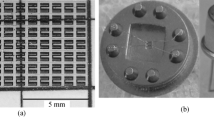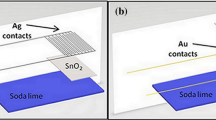Abstract
Scanning electron microscopy is used to examine the structure (of thin- and thick-film gas sensors based on Sn1‐x Sb x O2 solid solutions. The solid-solution particles are found not to sinter. The temperature dependences of the resistance and the volt-ampere characteristics of the films are studied. A mechanism for the gas sensitivity of the films to gas is suggested. In the model presented electrons are transported across grain-boundary Schottky barriers by thermoelectron emission and tunneling.
Similar content being viewed by others
References
N. P. Maksimovich, D. E. Dyshel', L. É. Eremina, et al., “Semiconductor sensors for checking the composition of gaseous media,” Zhurn. Analit. Khim., 45, No. 7, 1312–1316 (1990).
W. Göpel and K. D. Schierbaum, “SnO2 sensors: current status and future prospects,” Sensors and Actuators, 26/27, 1–12 (1995).
D. E. Dyshel', L. É. Eremina, N. P. Maksimovich, and B. M. Rud', “Adsorption ethyl alcohol vapor sensor based on powders of doped tin oxide,” Poroshk. Metall., No. 3, 95–98 (1989).
D. E. Dyshel', L. É. Eremina, N. P. Bliznuk, et al., “Properties of the surface of powders of the Sn(IV) — Sb — O system and sensor materials based on them,” Poroshk. Metall., Nos. 11–12, 60–65 (1993).
D. E. Dyshel', “Influence of the composition of Sn1 — xSbxO2 solid solutions on the sensitivity of semiconductor gas sensors,” Poroshk. Metall., Nos. 5–6, 96–99 (1996).
H. Torvela and S. Leppävuori, “Microstructure and conductivity of short duration sintered tin oxide ceramics,” Int. J. High Technology Ceramics, 3, 309–319 (1987).
T. Yamazaki, U. Mizutani, and Y. Iwama, “Electrical properties of SnO2 polycrystalline thin films and single crystals exposed to O2-and H2-gases,” Jpn. J. Appl. Phys., 22, No. 3, 454–459 (1983).
Y. Mizokawa and S. Nakamura, “ESR and electric conductance studies of the fine-powdered SnO2,” Jpn. J. Appl. Phys., 14, No. 6, 779–788 (1975).
D. Pyke, R. Reid, and R. Tilley, “Structures of tin-oxide — antimony oxide catalysts,” J. Chem. Soc., Faraday Trans. I, 76, 1174–1182 (1980).
J. Berry and C. Greaves, “A neutron diffraction investigation of the defect rutile structure of tin — antimony oxide,” J. Chem. Soc. Dalton Trans., 77, 2447–2451 (1981).
K. Singh, “Use of physical adsorption in the determination of the size of the surface area and the distribution by size of pores,” in: Catalyst Research Methods [Russian translation], Mir, Moscow (1983).
V. A. Kolbasova, I. N. Abramova, L. Kh. Bekker, and S. I. Matyusha, “Properties of materials based on tin oxide,” Élektron. Tekh. Ser. Mater., No. 6, 92–99 (1972).
D. A. Gedakyan, L. T. Grigoryan, K. A. Konstanyan, and L. A. Mkrtchyan, “Physics of sintering of doped tin oxide,” Steklo and Keramika, No. 12, 24–26 (1976).
D. E. Dyshel', B. M. Rud', V. B. Samoilov, and M. D. Kladkevich, “Influence a constant electric field on the properties of tin dioxide thick-film resistors,” Tekh. Sredstv. Svyazi. Ser. Tekhnol. Proizv. Oborud., No. 3, 60–66 (1987).
D. E. Dyshel’ and T. F. Lobunets, “Influence of heat treatment on the dispersion of Sn(IV) — Sb — O powders and the porosity of thick-film gas sensors based on them,” Poroshk. Metall., Nos. 5–6, 111–116 (1999).
C. Santilli and S. Pulsinelli, “Porosity evolution in SnO2 xerogels during sintering under isothermal conditions,” Phys. Rev. B, 51, No. 14, 8801–8809 (1995).
G. Harbeke (ed.), Polycrystalline Semiconductors, Springer Series in Solid-State Sciences, Vol. 57, Springer-Verlag, New York (1985).
W. Haiwang (ed.), Amorphe und polykristalline Halbleiter [Russian translation], Mir, Moscow (1987).
V. Ya. Sukharev and I. A. Myasnikov, “Electrical conductivity of a disordered semiconductor system with grain-boundary barriers due to adsorption of active particles,” Fiz. Tverd. Tela,27, No. 3, 705–709 (1985).
T. Umagaki, J. Nakajima, and Y. Nishimura, “Conduction mechanism of tin oxide film (optical and electrical properties),” Fujitsu Sci. Tech., 5, No. 3, 235–237 (1969).
K. C. Kao and W. Hwang, Electrical Transport in Solids, International Series in the Science of the Solid State, Vol. 14, Pergamon Pr. Inc., Elmsford, NY (1981).
J. Maier and W. Göpel, “Investigation of the bulk defect chemistry of polycrystalline tin(IV) oxide,” J. Solid State Chem.,72, 293–302 (1988).
E. Shanti, V. Dutta, A. Banerjee, and K. L. Chopra, “Electrical and optical properties of undoped and antimonydoped tin oxide films,” J. Appl. Phys. 51, No. 12, 6243–6251 (1980).
Author information
Authors and Affiliations
Rights and permissions
About this article
Cite this article
Dyshel', D.E. Influence of the Phase Composition on the Electrical Conductivity of Gas Sensors Based on Antimony-Doped Tin Dioxide Films. Powder Metallurgy and Metal Ceramics 40, 282–291 (2001). https://doi.org/10.1023/A:1012861701297
Issue Date:
DOI: https://doi.org/10.1023/A:1012861701297




